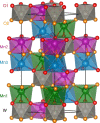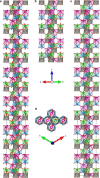Magnetostriction-polarization coupling in multiferroic Mn2MnWO6
- PMID: 29229914
- PMCID: PMC5725588
- DOI: 10.1038/s41467-017-02003-3
Magnetostriction-polarization coupling in multiferroic Mn2MnWO6
Abstract
Double corundum-related polar magnets are promising materials for multiferroic and magnetoelectric applications in spintronics. However, their design and synthesis is a challenge, and magnetoelectric coupling has only been observed in Ni3TeO6 among the known double corundum compounds to date. Here we address the high-pressure synthesis of a new polar and antiferromagnetic corundum derivative Mn2MnWO6, which adopts the Ni3TeO6-type structure with low temperature first-order field-induced metamagnetic phase transitions (T N = 58 K) and high spontaneous polarization (~ 63.3 μC·cm-2). The magnetostriction-polarization coupling in Mn2MnWO6 is evidenced by second harmonic generation effect, and corroborated by magnetic-field-dependent pyroresponse behavior, which together with the magnetic-field-dependent polarization and dielectric measurements, qualitatively indicate magnetoelectric coupling. Piezoresponse force microscopy imaging and spectroscopy studies on Mn2MnWO6 show switchable polarization, which motivates further exploration on magnetoelectric effect in single crystal/thin film specimens.
Conflict of interest statement
The authors declare no competing financial interests.
Figures





References
-
- Woodward PM, Sleight AW, Du L-S, Grey CP. Structural studies and order–disorder phenomenon in a series of new quaternary tellurates of the type A2+M4+Te6+O6 and A1+2M4+Te6+O6. J. Solid State Chem. 1999;147:99–116. doi: 10.1006/jssc.1999.8183. - DOI
-
- Ivanov SA, et al. Spin and dipole ordering in Ni2InSbO6 and Ni2ScSbO6 with corundum-related structure. Chem. Mater. 2013;25:935–945. doi: 10.1021/cm304095s. - DOI
-
- Oh YS, et al. Non-hysteretic colossal magnetoelectricity in a collinear antiferromagnet. Nat. Commun. 2014;5:3201. - PubMed
Publication types
LinkOut - more resources
Full Text Sources
Other Literature Sources

